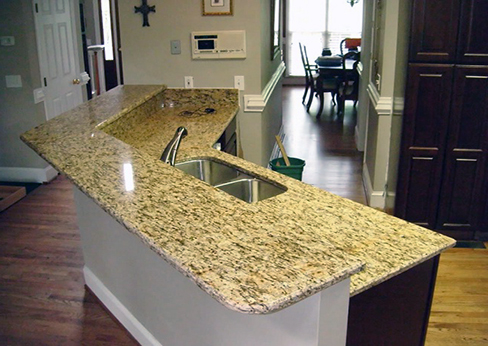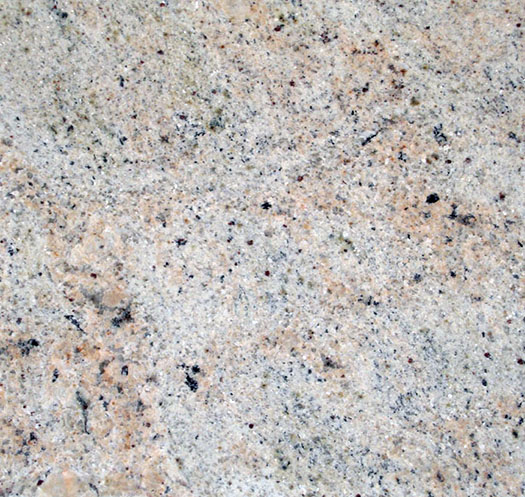Santa Cecilia granite is a stunning creamy white stone that is loved for its depth and beauty. It is quarried in Brazil and is occasionally called Giallo Cecilia granite. It’s a great choice for kitchen countertops – let’s learn a little more about this stunning stone.
From a distance Santa Cecilia looks reasonably uniform in its creamy color, no large mineral deposits will usually visible. The overall effect is slightly mottled, and while you cannot see the intricate patterns in detail, you are able to see that there is something more to this stone that demands a closer inspection.
When you get up close to the stone a stunning array of patterns present themselves. And they look amazing!
The bedrock of this stone is what gives it its overall creamy color. There is not much of a color variation within the bedrock itself and It can range from a light off white color through to a light cream.
This granite is littered with stunning black mineral deposits that are the most defining feature of this stone. They can range from a pure black right through to a very deep and dark red in color. They are usually very frequent throughout the stone and can cover up to 30% of a slabs overall surface area. This does not sound like a huge amount. But as these mineral deposits are almost always found in very small patches they are scattered throughout the stone – it is quite unusual to find sections that do not have at least some of these dark minerals in. The dark black contrasts against the stunning cream bedrock beautifully creating a mesmerizing overall effect.
Dotted infrequently around the stone will also be patches of a deep red mineral, almost burgundy in its color. These little minerals will only ever be found in tiny spots (less than 2cm in diameter) and do not make up more than 3% of a the stones overall mass. What these gorgeous little red minerals lack in frequency and size they make up for in beauty. Their stunning appearance complement the other mineral deposits adding a little splash of color to an otherwise reasonably neutral stone. I like to call them the little cherries on top.
Golden brown mineral deposits are also scattered throughout the stone. They can range in color from a light brown, through to a golden beige color. They will cover up to 30% of the stones surface area on average. They are a great addition to the this granite, seamlessly blending in with the bedrock – complementing the already stunning creamy colors. They add a level depth to the granite that transforms it from an “average” stone, to a stunning one.
Grey quartz deposits are also scattered throughout the stone, they are not found in huge amounts and can make up around 10% of the stones surface area on average. They can range from very light grey (basically white with a hint of grey) through to a medium grey color.
These grey quartz deposits are coupled with some white quartz deposits too. The white quartz is even less common than the grey quartz and is only found in very small patches.
Despite these two types of quartz not making up a huge amount of the stones mass – they add an incredible sparkle and shine to the stone. When the light glistens off of the quartz the overall effect is incredibly luxurious and inviting.
Santa Cecilia granite is very tough and will be able to withstand many years of usage under normal conditions. It is not known to be prone to staining and should be very easy to look after. Its overall light golden color and its detailed patterns are also much less likely to show up fingerprints and crumbs – meaning it is quite a low maintenance granite.
This granite is said to have an average level of variation between slabs. This means that when you are looking around to buy some of this stone, the slabs you will see can look very different from one another. While all aspects of this granite can vary the main varying factor is the black minerals in the stone. They can be found in larger vein like structures, or they can be found in very tiny speckles. They can be quite abundant, or they can be reasonably rare.
You basically need to take a look at any slab of this granite before you commit to buying it – as you could end up with a stone that looks very different to what you have pictured in your mind!
Santa Cecilia granite does vary a little depending upon the lighting conditions of the room – but not as much as some other granites. In rooms that have a large amount of natural light the creamy bedrock and the golden brown minerals will take on a more prominent position and the overall appearance of the stone will be much lighter.
In rooms without much natural light the burgundy minerals can seem black and the quartz will not have as much chance to reflect and sparkle in the light – meaning the your countertops will look a lot duller overall.
How Much Does Santa Cecilia Granite Cost?
Despite its huge popularity and high demand this is actually considered to be a low end granite. For a 3cm thick slab of Santa Cecilia granite you will pay around $35 to $45 per square foot. A 2cm thick slab will cost around $20 to $30 per square foot.
Santa Cecilia Granite is a stone loved because of its beauty, but also because of its versatility. It can fit in with a wide range of décor types, from dark to light, modern to vintage – this stone will be right at home.
When Santa Cecilia countertops are combined with light or white cabinets they are a soft little addition to a stark white kitchen. The creamy bedrock complements the white tones of the cabinets, and the dark black mineral deposits add a little depth to the room. The golden tones warm up the overall effect ensuring a clean, yet inviting appearance.
When you combine Santa Cecilia countertops with dark kitchen cabinets there is a slight contrast between the creamy granite and the dark cabinets. However the contrast is softened a little bit thanks again to the golden tones and dark mineral deposits. This color combination can easily be used to create a modern and contemporary feel to your kitchen, or can just as easily be used to create a homely traditional feel. The choice is yours!
A great little addition to the countertops is getting a matching Santa Cecilia Granite backsplash. As this granite is so cheap – It should not cost you more than $100 or so. And the difference it will make to the overall feel of your room is outstanding. There is something about that little extra piece of granite being used as a backsplash that makes a room feel much more luxurious. Such a great benefit for a minimal additional cost.
If you like the look of Santa Cecila we highly recommend you take a look at Golden Beach, Solarius, or Colonial Cream Granite too.
Do you have any of this granite in your home? We would love to know what you think! Please leave a comment in the box below!

















